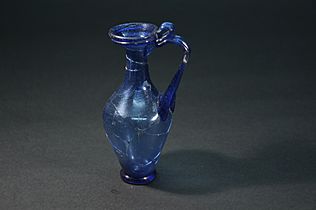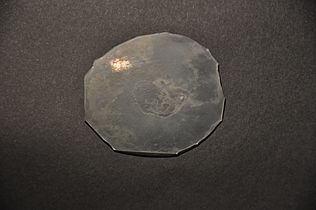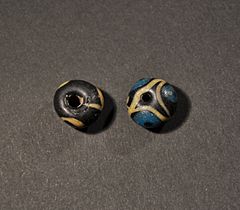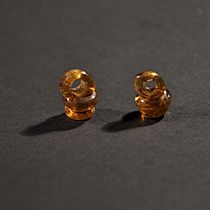Ivory Bangle Lady facts for kids
Quick facts for kids Ivory Bangle Lady |
|
|---|---|
| Created | late 3rd-4th century AD |
| Period/culture | Roman |
| Discovered | 1901 Sycamore Terrace, York, North Yorkshire |
| Present location | Roman Gallery, Yorkshire Museum, York |
The Ivory Bangle Lady is a skeleton found in Sycamore Terrace, York in 1901. She was a high-status adult female, potentially of North African descent, who died in York in the 4th century AD. Her skeleton was found with bracelets, pendants, earrings, beads as well as a glass jug and mirror. She appears to have originally been from North Africa. A piece of bone inscribed with the words, "Hail, sister may you live in God" was found with her skeleton.
Skeletal remains
A 2010 research paper studied the skeletal remains of the Ivory Bangle Lady, which were found within a stone coffin. This research showed that the skeleton is of a young adult female, aged 18–23 years. Her height was calculated using regression analysis of her limb-bone length to be approximately 152–160 cm. Significantly, this research also used FORDISC to identified the Ivory Bangle Lady as having North African ancestry. This conclusion was reached following craniometric multivariate analyses, including measuring Mahalanobis distance, which suggested a strong affinity with two reference populations of African-American females from the 19th and 20th Centuries. Isotope analysis of oxygen and strontium isotopes suggest that she spent her childhood in the west of Britain or in coastal areas of Western Europe and the Mediterranean. However, a 2009 study found that FORDISC 3.0 "is only likely to be useful when an unidentified specimen is more or less complete and belongs to one of the populations represented in its reference samples", and even in such "favorable circumstances it can be expected to classify no more than 1 per cent of specimens with confidence."
Grave goods
The Ivory Bangle Lady was buried wearing ivory and jet bangles, a bracelet of blue glass beads, silver and bronze pendants, two yellow-glass earrings. A small, round glass mirror, a dark blue glass flagon, and an openwork, ivory inscription plaque were also included in the grave. The plaque reads SOROR AVE VIVAS IN DEO ("Hail sister, may you live in God"), which is evidence for a Christian population in late Roman York. Whilst the plaque is clearly Christian, the existence of other grave goods and the alignment of the grave in a north-south (rather than east-west) arrangement strongly suggests that the lady interred was pagan, but had connections with a Christian community rather than herself being a Christian.
See also







